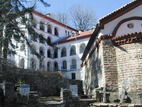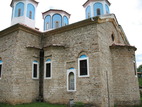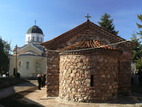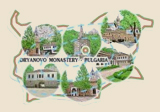Monasteries in Sofia region, Bulgaria
Most of Bulgarian monasteries are situated in the region of Bulgaria’s capital city, Sofia. The present-day Sofia and its surroundings have a significant influence on the Orthodox topography at Bulgarian lands during the time of Emperor Constantine The Great in the 4th century. The predominant part of the monasteries in Sofia’s region was established in the 13th century when was also marked the beginning of the grandiose monastery complex Mala, also called “minor Holy Mount” of Sofia. 14 monasteries are related to it and all of them are stretching along the stunning Vitosha Mountain and the neighbour mountains.
The main cultural and historical cloisters, most of which exist till nowadays, are huddled in the mountains around Sofia. These are: Dragalevtsi Monastery"Virgin Mary of Vitosha", Kladnitsa monastery “St.Nikolay”, Kokalyane Monastery “St. Archangel Michael”, German Monastery “St. Ivan Rilski”, Gorna Banya monastery “St. St. Kyril and Methodius” and many others. Many monasteries are located in the mountainous regions near Sofia, around Pernik and Radomir-Zemen Monastery “St. Ioan Bogoslov”, Peshtera monastery “St. Nikolay”; around Breznik-Bilinski Monastery “St. Archangel Michael”, Gigintsi monastery “St. St. Cosma and Damyan”; near Trun-Nedelishki Monastery “St. Atanasius” , Trun monastery “St. Archangel Michael”; Godech region-Razboishte monastery “The presentation of the Blessed Virgin”, Bukorovo Monastery “St. George the Victorious”, Godech Monastery “Holy Spirit”. All of the afore-mentioned monasteries, lying northwest in the Viskyar Mountain, Burel and Chepun, are closely related to Sofia’s monasteries.

Dragalevtsi Monastery "Virgin Mary of Vitosha"
Dragalevtsi Monastery was mentioned for the first time in the Vitosha golden-printed deed of the famous Bulgarian king Ivan Shishman (1371-1393). It revealed that the monastery had been established during the reign of Ivan Alexander (1331-1371), which means the period of the Second Bulgarian Kingdom. It is believed that the monastery was a part of the group of monasteries which arose in 14th and 15th century around Sofia.
monastery details
Etropole Monastery "St. Trinity"
The Etropole Monastery was established in the Middle Ages (1158). It is famous for its limestone base due to the limestone with which the monastery’s church was built. The legend says that the holy cloister’s existence may have been closely related to the name of the hermit Ivan Rilski, who had settled in one of the caves in the ‘Varovitets’ region before choosing solitude life in Rila. Nevertheless, the local people of Etropole declared the place holy and laid the foundations of the present-day monastery. Etropole “St.Trinity” monastery was one of the biggest literacy centres at Bulgarian lands in XVI and XVII century as the popular Etropole calligraphic and art school was established there.
monastery details
Kremikovtsi Monastery "St. George the Victorious"
It is believed that the Kremikovtsi Monastery was built during the reign of the king Ivan Alexander , but there is certain evidence for its existence from the 15th century. The oldest building there is the church “St.Georgi” dated back to the end of the 15th century and renovated two times. During the Ottoman Slavery the Kremikovtsi Monastery was an important literary and cultural centre for Sofia’s residents and many liturgical books have been transcribed there. Kremikovtsi cloister is a nunnery at the present
monastery details
Osenovlashki Monastery „Virgin Mary”
The legend says that the establishment of the Osenovlashki Monastery (the Seven Altars) is related to the name of the famous Bulgarian boyar Petar Deliyan and the rebellion against the Byzantine rule in 1040. The earliest historical evidence for the existence of the Osenovlashki Monastery was found in a Gospel dated back to 1511, and from another official document from 1554
monastery details

 Popular monastery
Popular monastery  Monastery
Monastery  Inactive monastery
Inactive monastery 
